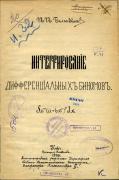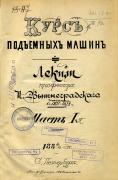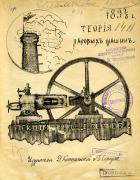1794 in Paris, it was started the first public technical school - Central School of Public Works (later renamed the Ecole polytechnique – Polytechnic School). One of the founders and organizers of the school was the famous French scientist Gaspard Monge, who believed that the main objective of the institution is to train qualified engineers. There were no textbooks for most subjects. Lectures were recorded from the voice of teacher and copied in many instances.
At the end of the XVIII century a lithography was invented - a way of reproduction paintings, drawings and texts, in which the image was applied to the lithographic stone. The prints are made from this stone. In the middle of the XIX century lithography of manuscripts was widespread for replication manuals.
Initiated and sponsored publications often could be either by the teacher or a group of students or an individual student. For some professors it was a matter of honor to print a tutorial on his own expense. The preparation of an edition was quite difficult: permission from the teacher to record his lectures; the invitation of a stenographer (sometimes the students themselves perform work or used teacher’s verbatim manuscript); viewing and editing of the text by the author; the transfer of the checked sheets in lithographic workshop.
Through a small circulation such publications sometimes were preserved in a single copy and have today great historical and scientific value. These lithographed manuals are usually not fall into the bookselling network: they bought up by the students themselves, and the book became private property (as evidenced by the inscription on the pages of proprietary publications). Often used after the exams these manuals were transferred to younger students (so the copies may be several owners' inscriptions), or to the library of the institution, or fall into the other libraries.
In the late XIX - early XX century student societies were issuing a large number of lithographed editions, and this practice was maintained throughout the first third of the twentieth century – until the appearance of a centralized state system of publishing and censorship control. The need in courses of lectures also arose because there was not always the opportunity to listen carefully to the teacher. Here are memories of one student in 1919-1921. "The listening of the lectures was always attentive. Students tried to record the presentation, but it was not always possible. [...] In this regard, for each subject there was formed a special group of students, they knew very well record or knew shorthand, and they were recording, putting usually at the table next to the pulpit. From time to time they checked their records, establishes joint thematics, which is then reviewed by the teacher and rewrote by trainees. Some of these courses were recorded on a typewriter, translated into stone and reproduction. But on the whole edition of lectures was not very common "( S. Narizhny, Poltava University. 1930).
The tradition of textbooks’ lithography in Kyiv Polytechnic Institute was developed during the existence of the institution. Teachers have developed various types of textbooks and tried promptly provide students with the necessary educational materials. The annual report on the activities of the institute contains an information about lithographed textbooks: "... Prof. Timofeev continued lithographed edition of the course of lectures on physical chemistry ... Prof. Nechaev AV issued lithographed lectures on crystallography and mineralogy ... prof. I.D Zhukov. - composed and lithographed the program for training students in the beet sugar factories "... Prof. De Metz G.G. published: lithographic edition guide students to "Explanation of physical measurements"; Physical Optics. Lithographed lectures for students; Acoustics. Lithographed lectures for students ... Prof. Farmakovsky VV published "The course of rolling stock and traction program engineering departments. second ed. (lithographic) ..." etc.
The collection of rare and valuable books our library has dozens of lithographed manuals. There are manuscripts and typescripts: individual lectures of professors and teachers, practical manuals, reference books, manuals for exams, albums, drawings and the like. All of them at different times were included to the fund, and most of them were donated to the library.
Among lithographed textbooks there are unique copies of works of teachers Kyiv Polytechnic V.L. Kirpichiov, G. De Metz, B. Bukreev, S. Kudashev, I. Belyankin, P. Zilov. No less valuable for us works of other eminent scientists: "The course of lifters" I. Visegradsky, "Analytical Geometry" outstanding Ukrainian mathematician G. Voronoi "Theoretical Mechanics" the founder of modern hydro and aerodynamics M. Zhukovsky, "Theory of steam engines" Professor of mechanics D. Zernov and others.
Unfortunately, some of the books from our collection have almost no output data: there is no place or year of publication or publisher. But, in general, the geography of lithographed editions represents the cities of the Russian Empire, where there were large schools: St. Petersburg, Moscow, Kiev, Kharkov, Warsaw, Tomsk.
The lithographed manuals can be found in the hall number 2.




